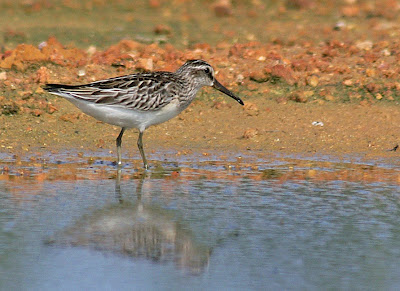I decided to put up my wardrobe hide, which was last put to good use last spring! I spent a lot longer than I should have trying to put the right poles in the right places (must label them for next time!), but eventually got the thing set up.

Once inside I knew I was in for a roasting! My wife thinks I may the only person in Malaysia that would choose to spend half a day under the tropical sun, lying in a wardrobe in the mud at a landfill site! She's almost certainly right ... in fact I may be the only person in the world!!
Anyway, despite the heat, the sweat and the smell, I had a superlative morning, taking over 500 pics!

First to arrive was a flock of 150 or so Pacific Golden Plovers. They were very suspicious of this new addition to the landscape at first, so I had to lie completely still, resisting the urge to take photos, till they relaxed.

Next to arrive was this Long-toed Stint, showing off its long toes!

A small flock of Long-toed Stints landed further away, with a lone Wood Sandpiper.

Then suddenly there were stints and sandpipers everywhere I looked, including this nice juvenile Broad-billed Sandpiper.

In this picture I managed to capture a juvenile Curlew Sandpiper (right), and adult Long-toed Stint (middle) and another adult stint, which on closer inspection, proved to be a Little Stint. And at the top of the pic, there's a dragonfly - Orthetrum sabina - for good measure!

A better view of the Little Stint. This is an adult moulting into winter plumage. The chestnut fringes to the greater and median coverts are what makes identification possible; Red-necked never shows chestnut fringes to the greater coverts; in breeding plumage they are grey-brown.

Seeing double! Here's the Little (on the left) with a juvenile Red-necked Stint. Notice the longer legs of the Little, especially the tarsus, and the thicker neck of the Red-necked.

Here's a second adult Little Stint with a juv Curlew Sandpiper. This one has moulted more of its scapulars than the other bird, but still retains a single diagnostic chestnut-edged greater covert.

Another Long-toed Stint with a juv Red-necked (on the right), The Long-toed's head is tiny compared to the Red-necked's!

A beautifully marked juvenile Curlew Sandpiper. Compare this bird ...

...with this one. Both are juvenile Curlew Sandpipers, but this one is much duller and greyer.

While I had been putting my hide up earlier, a single Black-tailed Godwit had flown over, calling. Presumably the same bird came back later with 5 others. Black-tailed Godwits are not common birds, so it was good to see them, especially as they were all birds hatched this year.

A trio of Tringas! Not a great photo, but good to see Wood Sandpiper (front), Marsh Sandpiper (back) and Common Redshank (left and right) together.

Lesser Sand Plovers were the commonest species, with good numbers of juveniles present.

There were still some adults with breeding colours around, but most had moulted into winter plumage.

A lone Ruddy Turnstone put in an appearance.

Terek Sandpipers were busily stalking the clouds of insects that hover just above the water surface.

There was a smattering of Greater Sand Plovers among the more numerous Lessers.

Terns were well-represented today, with Whiskered and White-winged around as well as a large flock of Little. Little Terns suffer chronically from panic attacks! Every few minutes they all fly up as if spooked by something, but then wheel around and sheepishly land in the same spot again. The other birds pretty much ignore their antics!

Sigh! Off they go again!
After a few hours I decided to try to scan the flock with my scope (not an easy feat in my cramped quarters!). In the midst of some sedges I came across a bird feeding with its back to me that I couldn't immediately identify. It reminded me of a Long-toed Stint but it was plainly much too big for one. My suspicions were confirmed when it eventually turned round to reveal a clear cut-off between the streaked breast and white belly - a Pectoral Sandpiper! It was difficult to photograph, as it preferred to feed among the vegetation, but it eventually gave itself up so I could get some 'record shots'.




I'm not very clear what the status of this species is in Malaysia. Some sources say it has occurred before, while others don't. At any rate, it's a pretty rare!
So despite the heat and the discomfort, I felt it was a morning well-spent!
4 comments:
What a fascinating report!
Thanks Jan.
yeah like your info about waders david and what's the status of this pectoral sandpiper at your place ?
There was one in Singapore in 1999, and a much earlier record in Penang in 1984. That's all I know of.
Post a Comment